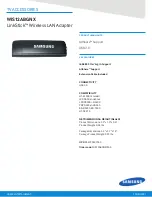
21020285 D
User’s Guide
Chapter 4 Command Operation
Page 4 - 6
The Base Status Block
The Base
Status Block
The Status Block is another of the building blocks of the command structures
you will be using when issuing commands. Used in conjunction with the
Parameter Block, its purpose is to report the outcome of a command you issued.
The Status Block format is the same whether you have issued a Pass-through
command or a Board-control command. It appears the same whether the
command structure you used is a Single Command or a Command List,
however there is a difference in the number of Status Blocks you may receive
for each type of command structure.
Single Command structures return only one Status Block. The Single
Command structure will contain only the last Status Block—the Status Block
with the CC (Command Complete) bit of the Flags byte set.
When you are using a Command List structure, multiple Status Blocks for any
one command are possible depending on the retry and Sense Byte selections
you have made (with the Unit Options or Extended Unit Options Board-control
commands).
Status Block
Format
The Status Block Format you will see used for all returned status information
is illustrated in the following figure:
Following is a brief description of each of the fields:
Command Identifier
- This value will identify which Parameter Block has
completed.
Flags
This byte can be polled to determine whether, and in what condition, a
command completed. It has this format:
TMS Target Mode Status
- This bit indicates that Status is being returned
from the Target Mode Response command.
0
⇒
The status was not a result of a Target Mode Response command.
1
⇒
The status is the result of a Target Mode Response command.
Address
Offset
Byte Memory Offset
0
1
2
3
00H
Command Identifier
04H
Error
Flags
08H
Status Information
0CH
Table 18: Base Status Block
BITS
7
6
5
4
3
2
1
0
CC
ERR
RTY
DTT
DTG
CSB
0
TMS
Table 19:
Summary of Contents for Rimfire 3880
Page 1: ...Rimfire 3880 SCSI Host Bus Adapter User s Guide Ciprico Inc Publication No 21020285 D...
Page 2: ......
Page 4: ...21020285 D User s Guide...
Page 25: ...2 H a r d w a r e E s s e n t i a l s...
Page 42: ...21020285 D User s Guide Chapter 2 Hardware Essentials Page 2 18 Descriptions of Port Usage...
Page 43: ...3 H a r d w a r e I n s t a l l a t i o n...
Page 59: ...4 C o m m a n d O p e r a t i o n...
Page 85: ...5 I n i t i a t o r M o d e P a s s t h r o u g h C o m m a n d s...
Page 103: ...6 T a r g e t M o d e P a s s t h r o u g h C o m m a n d s...
Page 125: ...7 B o a r d c o n t r o l C o m m a n d s...
Page 175: ...8 D e t a i l s o f U s a g e...
Page 193: ...A E r r o r C o d e s...
Page 201: ...B C a b l e s a n d C o n n e c t o r s...
Page 206: ...21020285 D User s Guide Appendix B Cables and Connectors Page B 6 VMEbus Connector Pinouts...
Page 207: ...C S p e c i f i c a t i o n s...
Page 210: ...21020285 D User s Guide Appendix C Specifications Page C 4 Specifications...
Page 211: ...D D e f a u l t s...
Page 216: ...21020285 D User s Guide Appendix D Defaults Page D 6 HardwareDefaults...
Page 217: ...E D e s i g n D i f f e r e n c e s...
Page 229: ......
Page 230: ...21020285 D...
















































